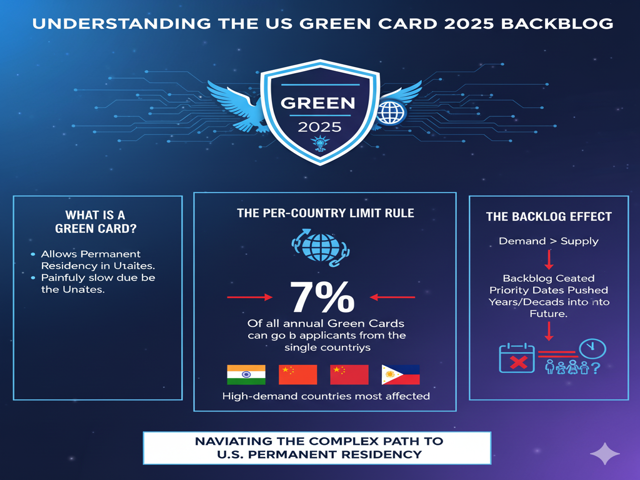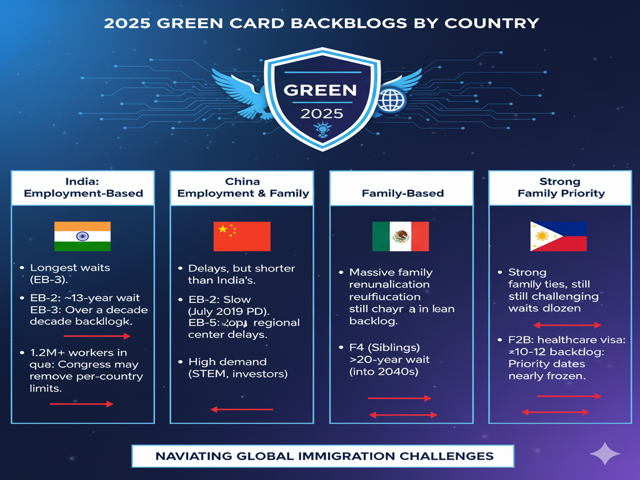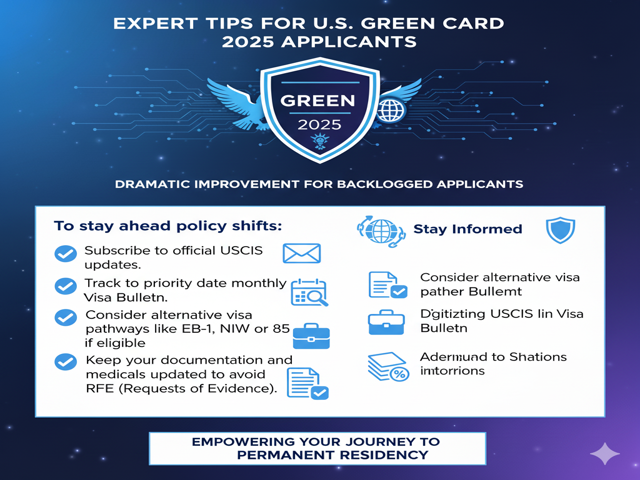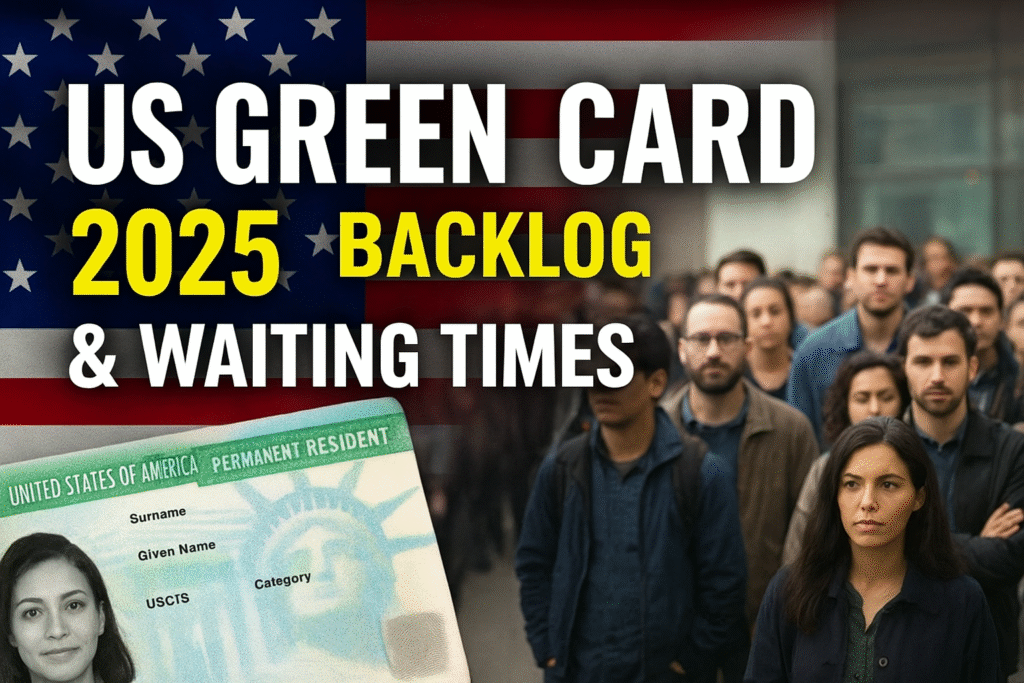US Green Card 2025 — The Global Waiting Game
The US Green Card 2025 backlog continues to be one of the biggest immigration challenges for skilled workers, families, and investors across the world. From India’s decades-long queues to Mexico’s family-based visa delays, millions of applicants are anxiously checking the Visa Bulletin 2025 for their priority dates.
In this guide, we break down how the country-specific backlog works, why certain nationalities face longer waits, and what possible reforms in 2025–2026 could finally improve the process.
Understanding the US Green Card 2025 Backlog
A Green Card allows permanent residency in the United States, but due to per-country limits and annual quotas, the process has become painfully slow for many.

Here’s how the system works:
- Each year, only 7% of all Green Cards can go to applicants from a single country.
- This limit affects high-demand countries like India, China, Mexico, and the Philippines.
- When demand exceeds supply, a backlog is created, pushing applicants’ priority dates years — even decades — into the future.
🇮🇳 India’s Employment-Based Green Card Backlog in 2025
Indian nationals face some of the longest Green Card waits in history, especially in the EB-2 (Advanced Degree Professionals) and EB-3 (Skilled Workers) categories.
Key 2025 Trends for Indian Applicants:
- EB-2 priority dates are currently around June 2012, meaning a 13-year wait.
- EB-3 category has moved slightly forward but remains backlogged over a decade.
- Over 1.2 million Indian workers are stuck in the employment-based queue.
Possible Change:
The US Congress is debating proposals to remove per-country limits or recapture unused visas, which could drastically reduce wait times for Indian professionals.

🇨🇳 China’s Family and Employment Visa Delays
Chinese applicants also experience long delays, though shorter than India’s.
In 2025:
- EB-2 China is moving slowly, with dates around July 2019.
- EB-5 (Investor Visa) remains a popular pathway, but regional center delays still impact approvals.
China’s strong participation in both the STEM and investor categories keeps demand high, especially as AI and biotech companies continue to petition foreign workers.
🇲🇽 Mexico’s Family-Based Visa Backlog
For Mexican nationals, the family reunification backlog remains massive in 2025.
- The F1 (unmarried adult children of US citizens) and F3 (married children) categories are moving slowly.
- The F4 (siblings of US citizens) category still shows waiting periods exceeding 20 years.
Example: A Mexican sibling applying today may not receive a Green Card until the 2040s unless policy changes occur.
🇵🇭 Philippines: Family Priority but Limited Movement
Filipino applicants benefit from strong family-based immigration programs, yet backlog times remain challenging.
- F2B (unmarried adult children of permanent residents) has a backlog of around 10–12 years.
- The nurse and healthcare visa categories continue to dominate employment-based petitions, but priority dates are nearly frozen.
The Visa Bulletin 2025: What to Watch
The Visa Bulletin published monthly by the US Department of State dictates which priority dates are eligible for Green Card issuance.

Key 2025 Highlights:
- Modest forward movement in EB-3 and EB-4.
- Family-based categories largely stagnant.
- Predictions show greater spillover from unused family visas to employment categories later in 2025.
To track your own waiting time, regularly visit the official Visa Bulletin page.
Why the US Green Card Backlog Matters
The Green Card backlog doesn’t just delay personal dreams — it affects the US economy, innovation pipeline, and family unity.
- Employers lose talent stuck abroad.
- Families face separation spanning decades.
- The US risks losing global talent to Canada, the UK, and Australia — countries with faster immigration paths.
Potential Reforms in 2025–2026
The Biden administration and Congress have both hinted at immigration modernization proposals for 2025–2026, including:

- Eliminating per-country caps for employment-based visas.
- Recapturing unused Green Cards from past years.
- Digitizing USCIS systems for faster processing.
- Automatic work authorization renewals for those stuck in limbo.
If implemented, these could dramatically improve waiting times for backlogged applicants.
Expert Tips for US Green Card 2025 Applicants

To stay ahead of policy shifts:
✅ Subscribe to official USCIS updates.
✅ Track your priority date monthly via the Visa Bulletin.
✅ Consider alternative visa pathways like EB-1, NIW (National Interest Waiver), or EB-5 if eligible.
✅ Keep your documentation and medicals updated to avoid RFEs (Requests for Evidence).
Related Post: US Visa Bulletin 2025 Predictions
FAQs: US Green Card 2025
Q1: What causes the Green Card backlog?
The backlog is caused by per-country limits and annual visa caps that restrict how many people can receive a Green Card each year.
Q2: How can I check my priority date?
You can track it on the US Department of State’s Visa Bulletin each month.
Q3: Will there be reform in 2025?
Yes, several proposals are being discussed to reduce backlogs and modernize the immigration process.
Q4: Which countries have the longest wait times?
Currently, India, Mexico, China, and the Philippines top the list.
Agent Advise: A Hopeful Outlook for Green Card Applicants
While the US Green Card 2025 backlog paints a challenging picture, there’s reason for optimism. With bipartisan discussions around immigration modernization, digital visa systems, and backlog reduction, the coming years could bring long-awaited relief for millions.
For now, staying informed and strategically planning your next step remains your most powerful tool.



